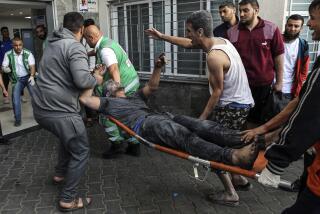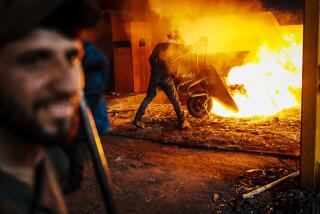Obama’s Afghanistan strategy has a familiar look
- Share via
Reporting from Kabul, Afghanistan, Baghdad and Washington -- In crafting his new Afghanistan policy, President Obama borrowed liberally from an unlikely source: the playbook of George W. Bush.
Obama was an outspoken critic of former President Bush’s decision to increase troop strength in Iraq in early 2007, a point nearly four years after the U.S.-led invasion when the country was in the midst of a sectarian war. He maintained his opposition throughout the presidential campaign, shrugging off Republican criticism that he was overlooking the subsequent decline in violence.
The Afghan strategy Obama announced Tuesday shares many similarities with the Iraq “surge”: a similar number of troops, a fast push into the country, a limited duration, an emphasis on training local forces and a hope of flipping the allegiance of insurgents.
But experts say there are key differences between the two countries, particularly in the nature of the insurgency, the terrain, the quality of security forces and the political atmosphere. Some of what worked in Iraq is likely to prove more difficult in Afghanistan, they say. And even in Iraq, after the added troops have left, all the gains are not necessarily secure.
“It is a concept very similar to the Iraq surge,” said Frederick Kagan, a military scholar at the American Enterprise Institute who helped conceive the Iraq buildup strategy and, on Afghanistan, advised Army Gen. Stanley A. McChrystal, the top U.S. and allied commander there, on his assessment of the war.
Scholars and Defense officials have debated which factors were the most critical in Iraq. What is not in doubt is that violence levels in Iraq dropped quickly, positioning the U.S. to begin the withdrawal of the large military force that remains, which is to begin after parliamentary elections early next year.
The buildup was supposed to give “time and space” for Iraqi security forces to develop, and for Iraqi politicians to make compromises on key legislation meant to reconcile sectarian factions. The security forces have improved, but reconciliation remains elusive.
Obama was dismissive of the “time and space” argument as a senator, but officials with his administration used the same language Tuesday, arguing that Obama’s plan would allow the Afghan government to develop its security forces, enact reforms and fight corruption.
Senior Defense officials said they looked carefully at the strategies that worked in Iraq while crafting the new Afghanistan policy.
Testifying Wednesday before a Senate committee, Defense Secretary Robert M. Gates wryly drew some comparisons between the two deployments, including the need to explain the strategies to skeptical lawmakers.
“This is the second surge I’ve been up here defending,” Gates said.
Most obviously, the two strategies employed a similar number of troops. Although Bush said at the time that his policy would add 21,500 troops, the total approached 30,000 when support troops were added in -- the same number Obama is adding in Afghanistan.
One of the most important developments in Iraq began largely independently of U.S. actions: when Sunni Arabs turned against the militants of the group Al Qaeda in Iraq. Sunni insurgents who had been fighting both Iraqi Shiite Muslims and foreign forces broke with the militants. Sunni tribal leaders who either had sympathized with the insurgency or feared speaking out against it quickly sought an alliance with U.S. forces. The Americans then helped organize them into local security forces and, in essence, paid them not to fight the U.S. or Iraqi militaries.
As violence has ebbed, there has been some success in bringing the former fighters into the political process. But relatively few have been given jobs in the security forces, as promised. Many of the original leaders of the Sunni revolt in Baghdad have been arrested, are in hiding or exile, or face legal proceedings.
In Afghanistan, getting militants to quit the insurgency may prove more difficult.
Military officials have been trying a variety of pilot projects aimed at getting Taliban foot soldiers to change sides and support local government elders.
“I think they should be faced with the option to come back if they are willing to come back under the constitution of Afghanistan . . . they can come back with dignity,” McChrystal told reporters in Kabul, the Afghan capital, after Obama’s speech.
Stephen Biddle, a military analyst with the Council on Foreign Relations who advised Army Gen. David H. Petraeus during the Iraq buildup and McChrystal on Afghanistan, cautioned that the Taliban rank and file may not switch allegiance as easily as the Sunni fighters did in Iraq.
The Sunnis, Biddle said, had been defeated in a sectarian civil war in Baghdad and had soured on their alliance with Al Qaeda in Iraq in the western province of Anbar. The Taliban, in contrast, believe they are winning.
“The key Taliban factions have just not been beaten on the battlefield,” Biddle said.
Defense officials and military experts caution that other differences between the two countries will be very important.
Unlike Iraq, which has a well-developed infrastructure, Afghanistan is rural and rugged, with very few usable roads. That leaves coalition troops far more dependent on air power and travel on remote rural tracks that the insurgents seed with roadside bombs.
“The situation in Afghanistan is a lot more complicated than Iraq, primarily because of the geography,” said David Sedney, a senior Defense official. “In many cases, you are almost fighting a different war every valley.”
Mark Moyar, an expert on counterinsurgency and a professor at the Marine Corps University, said other differences mean it will be difficult for the Afghanistan buildup to show results as quickly as the one in Iraq.
“Afghanistan’s population is highly dispersed, whereas Iraq’s is concentrated in cities,” Moyar said. “Thirty thousand troops can secure far more people when the population is concentrated than when it is spread out,” Moyar said
The enemy in Afghanistan is also different from the enemy in Iraq. Al Qaeda in Iraq was not considered an indigenous resistance movement, but the Taliban movement has deep roots in Afghanistan, drawing heavily on conservative Pashtun tribal traditions.
Though few in Afghanistan want to see the Taliban return to power, the movement presents itself as an alternative to the corruption that pervades all levels of the government.
The most important differences, officials said, are between the two countries’ armies.
By 2008, Iraqi security forces were showing vast improvement. When Prime Minister Nouri Maliki ordered his security forces to the southern city of Basra that spring in defiance of U.S. advice, he proved the capabilities of his army.
The Basra offensive and other operations by the Iraqi military proved to the Americans that their training of the force had succeeded, and that the Iraqis were ready to take a greater role in maintaining security.
Afghanistan’s army, which numbers about 95,000, has made some strides in training with concerted assistance from U.S. and other Western instructors. But U.S. military officials say the Afghan army is in far worse shape than Iraq’s was before the U.S. military buildup there. It has had a hard time attracting and retaining qualified soldiers.
The corrupt, poorly trained and underpaid police force is a bigger problem still. Even Afghan officials acknowledge that it will be a much more difficult undertaking to bring the police up to a reasonable standard.
The effort to strengthen Afghan security forces depends at least partly on the credibility of the central government of Afghan President Hamid Karzai, who was reelected this year in an election tainted by fraud. U.S. officials have roundly criticized his administration for being ineffective and corrupt.
In Iraq, many politicians view Bush’s gamble in 2007 as a success. But they are skeptical that the lessons can be applied to Afghanistan.
“The equation in Iraq was more realistic, and we are more open to the outside world,” said Ali Alaaq, a Shiite lawmaker with the ruling Islamic Dawa Party. “Iraq has political potential and talent . . . that the other country lacks.”
Doyle McManus and Peter Nicholas in the Washington Bureau contributed to this report.
More to Read
Get the L.A. Times Politics newsletter
Deeply reported insights into legislation, politics and policy from Sacramento, Washington and beyond. In your inbox twice per week.
You may occasionally receive promotional content from the Los Angeles Times.










